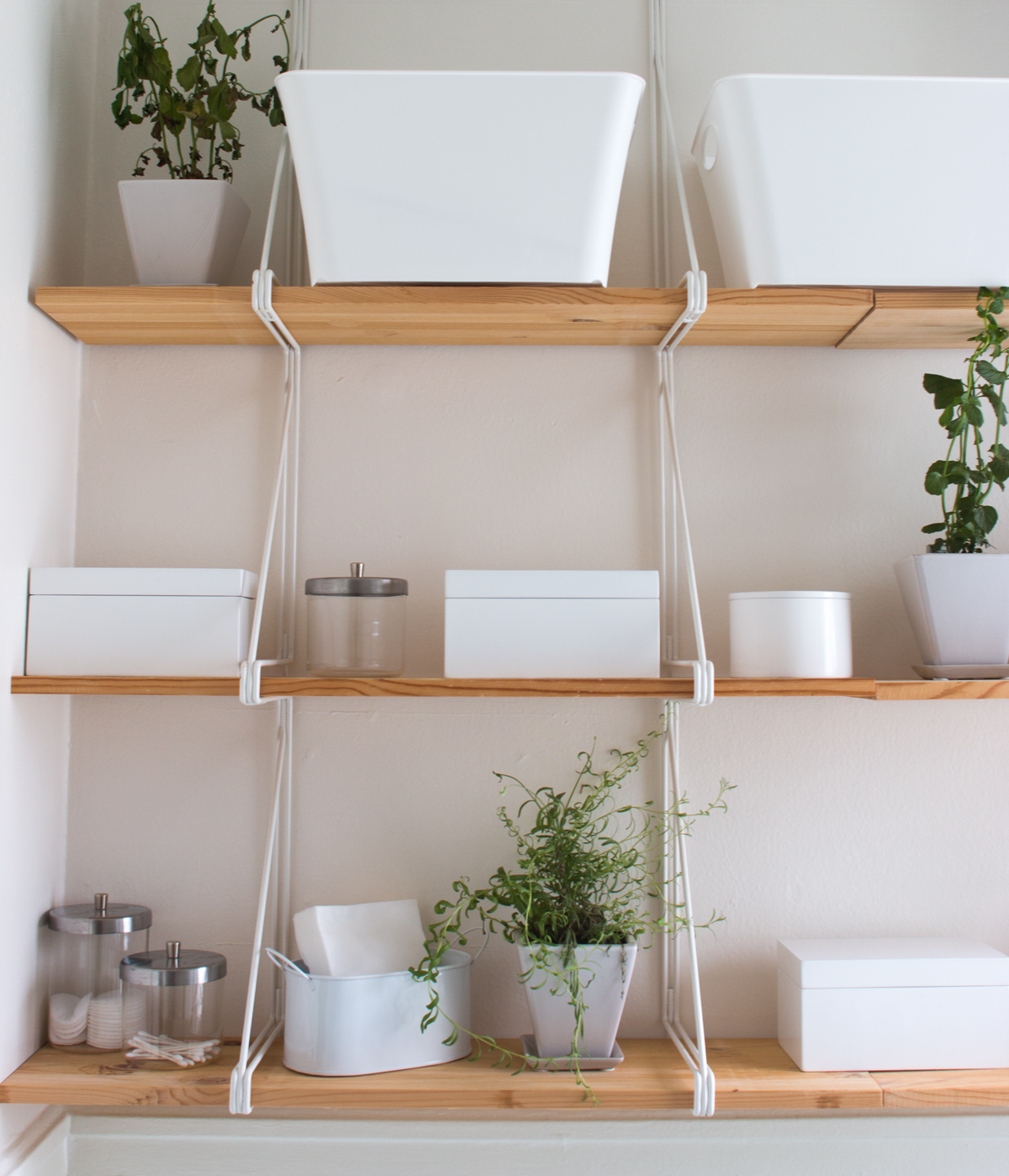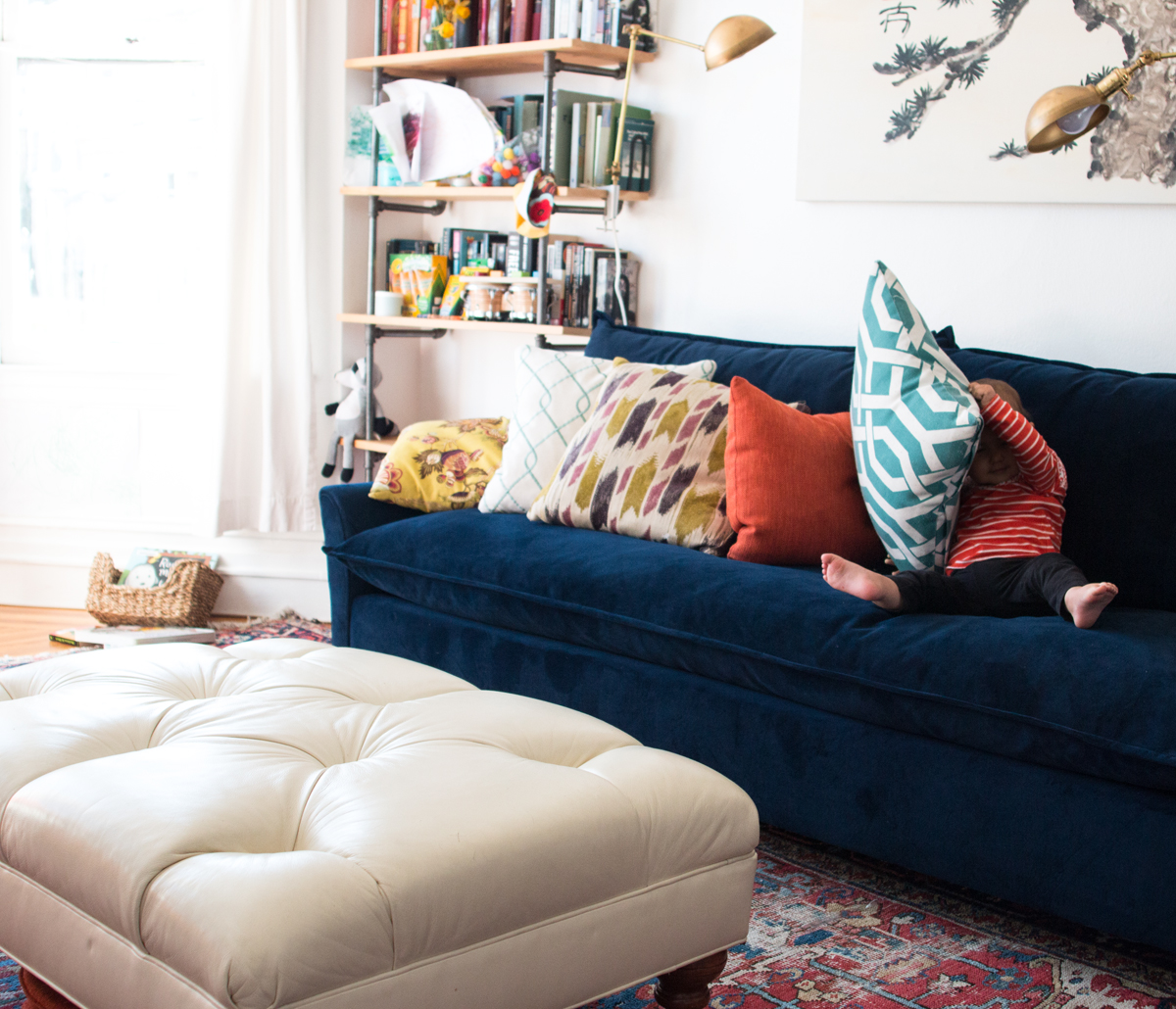So often, living small is paired with an overall minimalist lifestyle. But, what happens when you choose or have to live small, but still like all your things?
We’ve been living in our 650 sq ft apartment for 6 years now, after downsizing from a 1200 sq ft two bedroom apartment in Washington, DC. We donated and sold a lot of things, but we kept the cat and we gained a child.
All along, though, there have been things I haven’t been willing to let go of. As you may have guessed, I have a lot of hobbies. I like to cook. We both like books. I sew. Dave’s music collection is only surpassed by his audiophile toys. I like to do crafts at the drop of a hat. We build furniture and renovate our apartment. We could outfit a boy scout troop. We have outfitted snow boarders.
We have things, you see, and after six years, here’s what I’ve learned about living big in small space.
- You need to constantly re-evaluate how your home functions
Have you ever gotten so steeped in work or something else going on in your life, only to surface and take a look around your home and realize “what is even going on in here?” Like you haven’t actually looked at your space in a long time? Living small means having to regularly evaluate whether your home is still functioning or whether you need to fix it.
Signs your home isn’t functioning well: piles of clutter consistently mount in one location (on a chair in the bedroom, on a table in the living room, etc); you have a sense of UGH before opening your closets to get something out or put something in; you realize you haven’t been regularly cooking at home; there are rooms that you don’t really go into or hang out in.
In a large home, a chair draped with clothes would be an annoying thing, but perhaps an annoying thing that wouldn’t really bother you while you’re 100 feet away or more in your living room. In a small space, you end up seeing that messy chair throughout the day, and it’s likely bringing you down. Having a small space means having to deal with these little annoyances and finding a solution for them as they arise.
2. Contain everything
If it exists in our apartment, it’s in a container. Sterilite is my friend, specifically the air tight containers, because you can compress extra comforters, winter coats, and sleeping bags in them for easy top-of-the-closet-stacking. (More on that next.)
For smaller storage, we opt for The Container Store’s Shoe Box and Tall Shoe Box. Stacked and labelled, they are perfect for art, sewing, crafting and office supplies.
For visible storage, things not in closets, I opt for opaque baskets and bins, the color of the walls. Not necessarily white, but a color that blends into your wall color. The storage is easily accessible and out in the open, but it visually disappears into the wall and doesn’t add to the visible clutter. Monochromatic, visible storage is key for entryway shoes, diapers and baby stuff, and a variety of bathroom needs. Close at hand, but not visually obvious.
For things sitting around countertops or tabletops, put it on a tray. A tray instantly makes the clutter of salt grinders, olive oil, and garlic look intentional.
Translucent storage (glass jars, wire baskets) are reserved for visually-uniform items: Q-tips, face cleaning pads, toilet paper, towels, flour, sugar, rice, etc. If the items inside the bin aren’t visually uniform, put them in an opaque bin.
3. Think Vertical, Hidden Storage
Every article about small space living is all “think vertical!” When actually, it’s about thinking vertical behind closed doors. Shelves above your door aren’t going to help if what’s up there is a cluttery mess. The cluttery mess (which you have to see all day (see #1)) makes your space feel smaller than it is.
We max out our closet storage space with the help of large containers, stacked to the closet ceiling. As I mentioned in #2, if it’s storage out in the open (open shelves), I opt to put everything in bins the color of the wall. In either case, it takes advantage of tall ceilings and it’s hidden.

(Seen here: all of my makeup, nail polish, bandaids, hair accessories, dry wipes,
wet wipes, extra diapers, swim diapers, extra wipes boxes, Q-tips,
baby Q-tips, face cleaning pads, and extra contacts boxes.)
4. Re-evaluate what you actually want/need/use
Hobbies change over time, and living small means keeping only the things you really do want to work with some day. That collection of beads I thought I’d eventually do something with never panned out. Drawers of fabric that I kept around to be reused some day, never got used. Dave’s snow boarding gear got dusty, so he gave it to a friend’s teenager. When he found out his colleague’s daughter had really gotten into skateboarding, there went his (cherished, beloved) skateboard too. And, oh lord, all of this goes EXTRA for that shade of lipstick/eyeshadow you could never figure out how to wear.
It’s ok to be a maximalist in a small space, but you also want to be a deliberate maximalist.
5. Hold onto things you adore, and even then, re-evaluate
A friend recently confided her trick for figuring out what to keep or what to give away. If you are holding on to something because you might use it in the future or in a different apartment, mentally place yourself in that new upgraded palace…would you actually bring out that post-college Ikea coffee table in storage or would you start hunting for a new coffee table for the space? Likewise, when I was holding onto all of the fabric remnants, would I really use them again, or would I run to the fabric store to find something new?
If you absolutely adore something, then by all means, hold on to it because if it’s adored, you probably will find a way to use it again. But, sometimes, even if it is absolutely adored, it may just not work. Not now, not ever. We just had to give away our (OH MY GOD SO BEAUTIFUL) (like, inlaid-wood-beautiful) console table, because I haven’t figured out a way to make it fit in a 650 sq ft apartment in 6 years.
There is an element of wastefulness in this point — getting rid of things you aren’t using now but may purchase again in the future — but the reality is that we don’t know where we’re headed in the future, and holding onto that thing may be negatively impacting your life now. However, in the ways of sparking joy, if you only purchase things you adore, this point is likely to be less relevant to you moving forward. But, if you have purchased something that you don’t actually adore, holding onto it isn’t the solution.
With all of this hidden, maximized storage, I like to think our apartment is like a ship captain’s room. A place for everything, and everything goes in its place. That leaves our living areas open for simple furniture, minimalist table tops, and organized shelves.
Do you have any storage tips for living in a small space? Share them below!!







